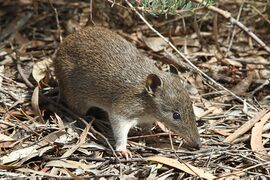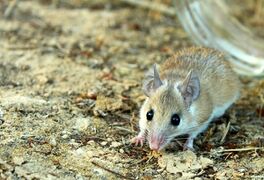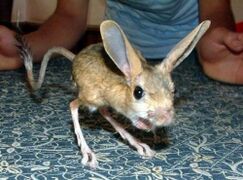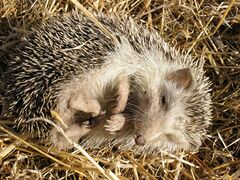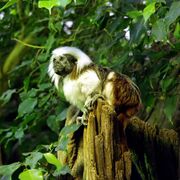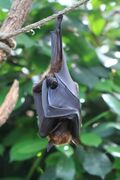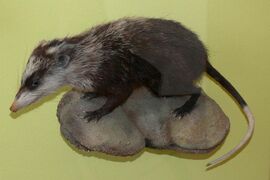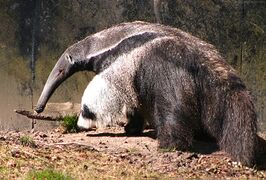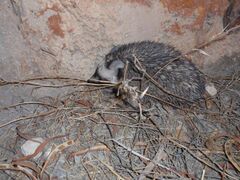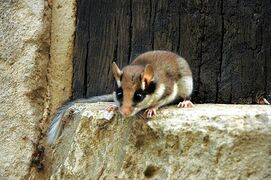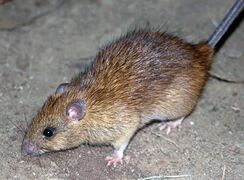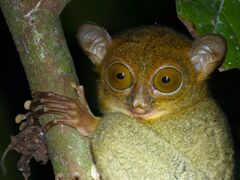Biology:Moniliformidae
| Moniliformidae | |
|---|---|
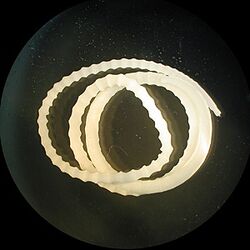
| |
| Adult Moniliformis moniliformis | |
| Scientific classification Error creating thumbnail: Unable to save thumbnail to destination
| |
| Domain: | Eukaryota |
| Kingdom: | Animalia |
| Phylum: | Acanthocephala |
| Class: | Archiacanthocephala |
| Order: | Moniliformida Schmidt, 1972 |
| Family: | Moniliformidae Van Cleave, 1924 [1] |
Moniliformidae is a family of parasitic spiny-headed (or thorny-headed) worms. It is the only family in the Moniliformida order and contains three genera: Australiformis containing a single species, Moniliformis containing eighteen species and Promoniliformis containing a single species. Genetic analysis have determined that the clade is monophyletic despite being distributed globally. These worms primarily parasitize mammals, including humans in the case of Moniliformis moniliformis, and occasionally birds by attaching themselves into the intestinal wall using their hook-covered proboscis. The intermediate hosts are mostly cockroaches. The distinguishing features of this order among archiacanthocephalans is the presence of a cylindrical proboscis with long rows of hooks with posteriorly directed roots and proboscis retractor muscles that pierce both the posterior and ventral end or just posterior end of the receptacle. Infestation with Monoliformida species can cause moniliformiasis, an intestinal condition characterized as causing lesions, intestinal distension, perforated ulcers, enteritis, gastritis, crypt hypertrophy, goblet cell hyperplasia, and blockages.
Taxonomy and description
Species of the family Moniliformidae are usually pseudosegmented and have a cylindrical proboscis with longitudinal rows of hooks that have posteriorly directed roots. Moniliformidae are further characterized by the presence of a simple, double-walled proboscis receptacle with the outer wall having spirally aligned muscle fibers (with the exception of Australiformis), brain at posterior end of receptacle, and dorsal and ventral lacunar canals.[2][3] The proboscis retractor muscles pierce both the posterior and ventral end or just posterior end of the receptacle.[4] The cerebral ganglion is in the mid to posterior region, and the lemnisci are long and flat and not bound to the body wall. These worms also lack protonephridia and males have eight cement glands, each with a giant nucleus, which are used to temporarily close the posterior end of the female after copulation.[2][3][5] Genetic analysis has been conducted on four species: Moniliformis moniliformis, M. saudi, M. cryptosaudi and M. kalahariensis.[6][7] Based on these results, Moniliformidae has been determined to be monophyletic.[6][7]
| Archiacanthocephala | |||||||||||||||||||||||||||||||||
| |||||||||||||||||||||||||||||||||
| Phylogenetic reconstruction for select species in the class Archiacanthocephala[8][9] |
Species
There are three genera and twenty living species in the order Moniliformida.[6][10][11][lower-alpha 1]
Australiformis
Australiformis is a monotypic genus that infest marsupials in Australia and New Guinea. Its body consists of a proboscis armed with hooks which it uses to pierce and hold the gut wall of its host, and a long trunk. It contains a single species, Australiformis semoni. This genus resembles species in the genus Moniliformis but is characterized by a lack of spiral muscles in the outer wall of the proboscis receptacle. The proboscis is armed with 12 rows of 13 to 15 hooks which are used to attach themselves to the small or large intestines of the host. The female worms range from 95 to 197 millimetres, long virtually all of which is the trunk, and 1.75 to 3.5 millimetres wide. There is pronounced sexual dimorphism in this species as females are around twice the size of the males whose trunks range from 46 to 80 millimetres long and 2 millimetres wide.[2] Infestation of marsupials by A. semoni may cause debilitating inflammation of the stomach (gastritis) with granulomatous ulcers.[12]
Moniliformis
The genus Moniliformis Travassos, 1915 contains eighteen species. Description of the genus is the same as the family Moniliformidae with the exception of possessing spiral muscles in the outer wall of the proboscis receptacle[2] and a single distinct kind of proboscis hooks.[13]
- Moniliformis acomysi Ward and Nelson, 1967[13]
- Moniliformis aegyptiacus Meyer, 1932[14]
- Moniliformis amini Martins, del Rosario Robles, and Navone 2017[15]
- Moniliformis cestodiformis (Linstow, 1904)[lower-alpha 2]
- Moniliformis clarki (Ward, 1917)[lower-alpha 3]
- Moniliformis convolutus Meyer, 1932
- Moniliformis cryptosaudi Amin, Heckmann, Sharifdini, and Albayati, 2019[7]
- Moniliformis echinosorexi Deveaux, Schmidt and Krishnasamy, 1988[17]
- Moniliformis gracilis (Rudolphi, 1819)[lower-alpha 4]
- Moniliformis ibunami[18]
- Moniliformis kalahariensis Meyer, 1931
- Moniliformis moniliformis (Bremser, 1811)[lower-alpha 5]
- Moniliformis monoechinus (Linstow, 1902)[lower-alpha 6]
- Moniliformis necromysi Gomes, Costa, Gentile, Vilela and Maldonado, 2020[19]
- Moniliformis saudi Amin, Heckmann, Mohammed, & Evans, 2016[6]

- Moniliformis siciliensis Meyer, 1932[lower-alpha 7]
- Moniliformis spiralis Subrahmanian, 1927
- Moniliformis tarsii Deveaux, Schmidt and Krishnasamy, 1988[17]
- Moniliformis travassosi Meyer, 1932
Promoniliformis
The genus Promoniliformis Dollfus and Golvan, 1963[20] is characterized by possessing two distinct kinds of proboscis hooks.[13] There is only one species in this genus. It contains a single species Promoniliformis ovocristatus (Linstow, 1897)
Hosts
Moniliformidae species are found in the intestines parasitizing mammals and occasionally birds.[4] Intermediate hosts are mostly cockroaches but also other insect groups.[6] Infestation can cause moniliformiasis, which is characterized as lesions in the intestines, intestinal distension, perforated ulcers, enteritis, crypt hypertrophy, goblet cell hyperplasia, and occlusions of the intestinal tract in the gray squirrel (Sciurus carolinensis).[21]
- Hosts for Moniliformidae species
The Southern brown bandicoot is a host for Australiformis semoni
The Cairo spiny mouse is a host of Moniliformis acomysi
The four-toed jerboa is a host of Moniliformis aegyptiacus
The North African hedgehog is a host of Moniliformis aegyptiacus
The large flying fox is a host of Moniliformis convolutus
The long-eared hedgehog is a host of Moniliformis cryptosaudi
The giant anteater is a host of Moniliformis monoechinus
The desert hedgehog is a host of Moniliformis saudi
The brown rat is a host of M. siciliensis and Moniliformis travassosi
The black rat is a host of Moniliformis spiralis
The Horsfield's tarsier is a host of Moniliformis tarsii
Promoniliformis ovocristatus is a parasite of the tailless tenrec
Promoniliformis ovocristatus is a parasite of the lesser hedgehog tenrec
Notes
- ↑ A binomial authority in parentheses indicates that the species was originally described in a genus other than the present genus.
- ↑ M. cestodiformis originally named Echinorhynchus cestodiformis by von Linstow in 1904[16] but was renamed by Travassos in 1917. It is synonymous with Moniliformis erinacei Southwell and Macfie, 1925[11][6]
- ↑ M. clarki was originally named Hormorhynchus clarki by Ward in 1917 but was renamed by Chandler in 1921. It is synonymous with M. spiradentatis Mcleod, 1933.[11][6]
- ↑ M. gracilis was originally named Echinorhynchus gracilis by Rudolphi in 1819 but was renamed by Meyer in 1931.[11][10]
- ↑ M. moniliformis originally named Echinorhynchus moniliformis by Bremser in 1811 but was renamed by Travassos in 1915. It is synonymous with E. grassiRailliet, 1893, E. canis Porter, 1914, E. belgicus Railliet, 1919, M. dubius Meyer, 1932, and M. travassosi Meyer, 1932[11][10][15]
- ↑ M. monoechinus was originally named Echinorhynchus monechinus by Linstow in 1902 but was given its present name by Petrochenko in 1958.[10] It is often incorrectly spelled M. monechinus.[6]
- ↑ M. siciliensis is synonymous with M. pseudosegmentatus (Knüppfer, 1888)[10]
References
- ↑ Van Cleave, H. J. (1924). "A Critical Study of the Acanthocephala Described and Identified by Joseph Leidy". Proceedings of the Academy of Natural Sciences of Philadelphia 76: 279–334.
- ↑ 2.0 2.1 2.2 2.3 Schmidt, Gerald D.; Edmonds, Stanley J. (1989). "Australiformis semoni (Linstow, 1898) n. Gen., n. Comb. (Acanthocephala: Moniliformidae) from Marsupials of Australia and New Guinea". The Journal of Parasitology 75 (2): 215–7. doi:10.2307/3282769. PMID 2926590.
- ↑ 3.0 3.1 Kükenthal, W (2014). Gastrotricha and Gnathifera. Göttingen, Germany: Walter de Gruyter. p. 322. ISBN 978-3110274271. https://books.google.com/books?id=hwCTBgAAQBAJ&q=apororhynchus&pg=PP11.
- ↑ 4.0 4.1 Amin, O. M. (1987). "Key to the families and subfamilies of Acanthocephala, with the erection of a new class (Polyacanthocephala) and a new order (Polyacanthorhynchida)". Journal of Parasitology 73 (6): 1216–1219. doi:10.2307/3282307. PMID 3437357.
- ↑ Bush, Albert O.; Fernández, Jacqueline C.; Esch, Gerald W.; Seed, J. Richard (2001). Parasitism : the diversity and ecology of animal parasites. Cambridge, UK New York, NY: Cambridge University Press. p. 203. ISBN 0-521-66278-8. OCLC 44131774.
- ↑ 6.0 6.1 6.2 6.3 6.4 6.5 6.6 6.7 6.8 Amin, Omar M.; Heckmann, Richard A.; Osama, Mohammed; Evans, R. Paul (2016). "Morphological and molecular descriptions of Moniliformis saudi sp. n. (Acanthocephala: Moniliformidae) from the desert hedgehog, Paraechinus aethiopicus (Ehrenberg) in Saudi Arabia, with a key to species and notes on histopathology". Folia Parasitologica 63. doi:10.14411/fp.2016.014. ISSN 0015-5683. PMID 27189420.
- ↑ 7.0 7.1 7.2 Amin, Omar M.; Heckmann, Richard A.; Sharifdini, Meysam; Albayati, Nagham Yaseen (2019). "Moniliformis cryptosaudi n. sp. (Acanthocephala: Moniliformidae) from the Long-eared Hedgehog Hemiechinus auritus (Gmelin) (Erinaceidae) in Iraq; A Case of Incipient Cryptic Speciation Related to M. saudi in Saudi Arabia". Acta Parasitologica 64 (1): 195–204. doi:10.2478/s11686-018-00021-9. PMID 30666546.
- ↑ Nascimento Gomes, Ana Paula; Cesário, Clarice Silva; Olifiers, Natalie; de Cassia Bianchi, Rita; Maldonado, Arnaldo; Vilela, Roberto do Val (December 2019). "New morphological and genetic data of Gigantorhynchus echinodiscus (Diesing, 1851) (Acanthocephala: Archiacanthocephala) in the giant anteater Myrmecophaga tridactyla Linnaeus, 1758 (Pilosa: Myrmecophagidae)". International Journal for Parasitology: Parasites and Wildlife 10: 281–288. doi:10.1016/j.ijppaw.2019.09.008. PMID 31867208.
- ↑ Amin, O.M.; Sharifdini, M.; Heckmann, R.A.; Zarean, M. (2020). "New perspectives on Nephridiacanthus major (Acanthocephala: Oligacanthorhynchidae) collected from hedgehogs in Iran". Journal of Helminthology 94: e133. doi:10.1017/S0022149X20000073. PMID 32114988.
- ↑ 10.0 10.1 10.2 10.3 10.4 Amin, Omar M. (September 19, 2013). "Classification of the Acanthocephala". Folia Parasitologica 60 (4): 273–305. doi:10.14411/fp.2013.031. PMID 24261131.
- ↑ 11.0 11.1 11.2 11.3 11.4 "Moniliformida Schmidt, 1972". November 23, 2019. https://www.itis.gov/servlet/SingleRpt/SingleRpt?search_topic=TSN&search_value=196572.
- ↑ Lenhaus, Cornelius; Obendorf, David; Wright, Frank H. (1990). "Veterinary aspects of Perameles gunnii biology with special reference to species conservation". in Clark, Tim W.. Management and conservation of small populations. Chicago Zoological Society. pp. 89–108. ISBN 0-913934-16-X. https://www.researchgate.net/publication/258341847. Retrieved March 23, 2020.
- ↑ 13.0 13.1 13.2 Ward, Helen L.; Nelson, Diane R. (1967). "Acanthocephala of the Genus Moniliformis from Rodents of Egypt with the Description of a New Species from the Egyptian Spiny Mouse (Acomys cahirinus)". The Journal of Parasitology 53 (1): 150–156. doi:10.2307/3276638. PMID 6066757.
- ↑ Meyer, A. (1932). "Acanthocephala" (in de). Dr. H.G. Bronn's Klassen und Ordnungen des TierReichs (Akad. Verlag, Leipzig) 4: 1–332.
- ↑ 15.0 15.1 Guerreiro Martins, Natalia Beatriz; del Rosario Robles, María; Navone, Graciela Teresa (August 2017). "A new species of Moniliformis from a Sigmodontinae rodent in Patagonia (Argentina)". Parasitology Research 116 (8): 2091–2099. doi:10.1007/s00436-017-5508-9. PMID 28585077.
- ↑ von Linstow, O. (1904). "Neue Helminthen aus Westafrika". Centralbl. Bakt. Parasitenk., U. Lnfektionskr., Abt 1 (36): 380–383.
- ↑ 17.0 17.1 Deveaux, Timothy P.; Schmidt, Gerald D.; Krishnasamy, M. (1988). "Two New Species of Moniliformis (Acanthocephala: Moniliformidae) from Malaysia". The Journal of Parasitology 74 (2): 322–5. doi:10.2307/3282462. PMID 3128654.
- ↑ Lynggaard, Christina; García-Prieto, Luis; Guzmán-Cornejo, Carmen; García-Varela, Martín (1 August 2021). "Description of a new species of Moniliformis (Acanthocephala: Moniliformidae) from Peromyscus hylocetes (Rodentia: Cricetidae) in Mexico". Parasitology International 83: 102315. doi:10.1016/j.parint.2021.102315. PMID 33677125.
- ↑ Gomes, A.P.N.; Costa, N.A.; Gentile, R.; Vilela, R.V.; Maldonado, A. (2020). "Morphological and genetic description of Moniliformis necromysi sp. n. (Archiacanthocephala) from the wild rodent Necromys lasiurus (Cricetidae: Sigmondontinae) in Brazil". Journal of Helminthology 94: e138. doi:10.1017/S0022149X20000188. PMID 32188515.
- ↑ Dollfus, Robert-Ph.; Golvan, Yves-J. (1963). "Sur un singulier Métacanthocéphale parasite d'insectivores (Tenrecinae) de Madagascar et des Comores". Annales de Parasitologie Humaine et Comparée 38 (5): 793–806. doi:10.1051/parasite/1963385793.
- ↑ Singleton, Jeurel; Richardson, Dennis J.; Lockhart, J. Mitchell (January 1993). "Severe Moniliformiasis (Acanthocephala: Moniliformidae) in a Gray Squirrel, Sciurus carolinensis, from Arkansas, USA". Journal of Wildlife Diseases 29 (1): 165–168. doi:10.7589/0090-3558-29.1.165. PMID 8445783.
Wikidata ☰ Q3449713 entry
 |
